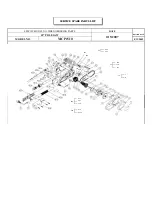
-22-
sides of a replacement blade. These are metal
plates positioned against the sides of the blade to
reduce deflection that may occur when using thin
saw blades. Use of these devices on both sides
will prevent the blade from being properly aligned
with the riving knife / splitter, which may bind the
work piece during cutting. One “stabilizer” plate
may be placed only against the outside of a thin
replacement blade. These plates are not required
with the supplied blade.
CHANGING THE BLADE
NOTE: Clean blade of any excess oil before
installation.
1. Remove the table insert (Fig. 11).
2. Raise the blade to the maximum height by
turning the control wheel clockwise (Fig. 11).
3. Lift up arbor lock lever and slowly rotate the
blade by hand until the lock fully engages the
saw arbor and stops rotation (Fig. 12).
Table Insert
Blade
Control
Wheel
Arbor Lock
Lever
REMOVAL AND INSTALLATION
OF THE BLADE
Disconnect the plug from the
power source before per-
forming any assembly, adjustment or repair to
avoid possible injury.
USING THE CORRECT BLADE
IMPORTANT: The saw blade provided on this
tool has a diameter of 10 inches, a carbide-tipped
kerf width of .102," and a plate (body) thickness
that is .071" thick. When looking for a replacement
blade, select one with dimensions close to the
original blade. This information may not be printed
on the blade’s packaging. If it is not, check the
manufacturers catalog or website. Skilsaw offers
Premium-Quality Professional saw blades that
match the requirements for this tool. You must se-
lect a blade with a kerf width of .092" or more and
a plate (body) thickness .088" or less (Fig. 10).
RIVING KNIFE
KERF WIDTH
BLADE BODY
PLATE
.090"
MUST BE .092"
OR MORE
MUST BE LESS
THAN .088"
BLADE TEETH
To reduce the risk of injury,
do not use extra thin kerf saw
blades. The kerf of the blade must be wider than
.092." Extra thin kerf saw blades (less than .092")
may cause the work piece to bind against the riv-
ing knife / splitter during cutting. It is recommended
that the kerf of the replacement blade used on this
saw be .092" or more.
To reduce the risk of injury,
do not use saw blades made
with a thick body plate. If the replacement saw
blade’s plate thickness is greater than .088," the
riving knife / splitter would not properly serve as an
aid to reduce kickback. The replacement blade’s
plate thickness must be less than .088."
To reduce the risk of injury,
do not use blade “dampers
,” “stabilizers,” or “stiffening collars” on both
Assembly
FIG. 10
FIG. 11
FIG. 12
















































